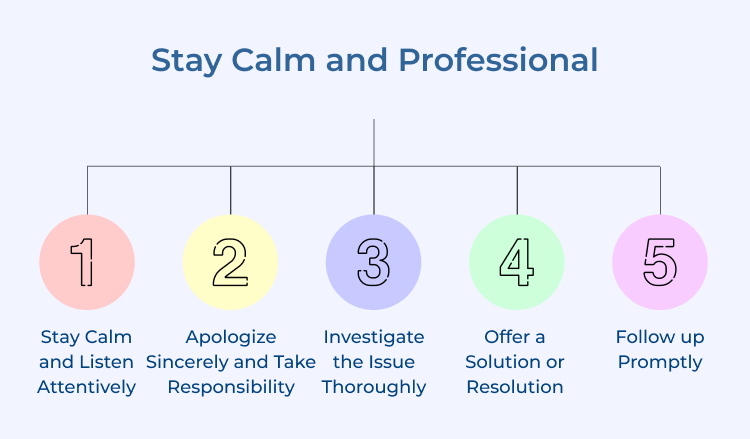1. Listen to the Customer: Handle customer complaints by listening carefully to what the customer is saying. Let them express their concerns without interrupting and show that you understand their frustration.
2. Apologize and Take Responsibility: Even if the customer’s complaint is unwarranted, it’s important to apologize for any inconvenience. Taking responsibility for the situation can go a long way in diffusing tension and showing the customer that you care about their satisfaction.
3. Resolve the Issue Quickly: Identifying the root cause of the customer’s complaint, help to quickly find a solution. Whether it’s offering a refund, replacing a faulty product or providing a discount on future purchases, make sure that the customer leaves the interaction feeling satisfied with the resolution.
4. Follow-Up After Resolution: After resolving the complaint, follow up with the customer to ensure that they are happy. It can help to build trust and loyalty with the customer, showing them that you are committed to their satisfaction.
5. Learn from the Experience: Every customer complaint is an opportunity to learn and improve your business practices. Take the time to analyze the complaint and see if there are any trends or common issues that need to be addressed to prevent similar complaints in the future.
Examples of Handling a Customer Complaint
Customer complaints are a natural part of running a business and how you handle them can make or break your reputation. It’s important to address complaints promptly, effectively, and with empathy to retain customer loyalty.
Here are some real-life examples of effectively handling a customer complaint:
1. Zappos
Zappos, the online shoe and clothing store known for its exceptional customer service, is a great example of handling customer complaints effectively. In one instance, a customer called to return a pair of shoes because her husband had passed away and would no longer need them.
The takeaway approach:
The Zappos customer service representative not only processed the return but also sent a bouquet to the customer. This act of kindness was expected and solidified the customer’s loyalty to the brand.
2. Southwest Airlines
Southwest Airlines is another company that is known for its excellent customer service. In one case, a customer complained on Twitter about a delayed flight and missing her sister’s wedding as a result.
The takeaway approach:
Southwest Airlines responded quickly, apologized for the inconvenience, and offered the customer a complimentary flight to make up for the missed wedding. The customer was impressed by the airline’s response and felt valued as a customer.
3. Nordstrom
Nordstrom is famous for its generous return policy, which allows customers to return items with no time limit and no questions asked. In one case, a customer returned a set of tires to Nordstrom, even though the store does not sell tires.
The takeaway approach:
Instead of turning the customer away, Nordstrom accepted the return and issued a refund. The unexpected act of customer service went viral and further solidified Nordstrom’s reputation for exceptional customer service.
4. Starbucks
Starbucks is no stranger to customer complaints, especially when it comes to getting orders wrong. In one case, a customer received the wrong drink order and took to social media to voice her frustration.
The takeaway approach:
Starbucks responded quickly, apologized for the mistake, and offered the customer a free drink as a gesture of goodwill. The customer appreciated the prompt response and felt valued by the company.
Address Root Causes of Customer Complaints for Exceptional Service
Addressing the root causes of customer complaints is essential in providing exceptional service.
Identifying and resolving the underlying issues that lead to dissatisfaction can improve customer satisfaction
Taking proactive steps to prevent complaints, such as improving communication, training staff, and implementing quality control measures, can help prevent future issues. Consistently addressing customer concerns can enhance their reputation, and build customer trust that will drive success. Prioritizing a customer-centric approach to address the root causes will lead to long-term positive outcomes for both businesses and their customers.










